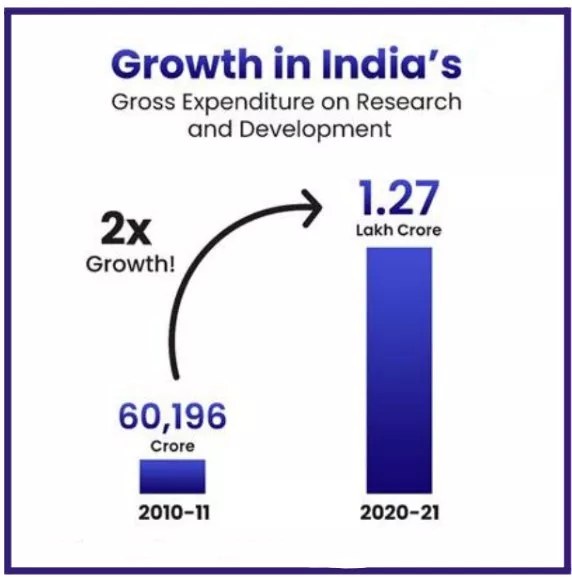Recently, the Research, Development and Innovation (RDI) Scheme was launched during the inauguration of the Emerging Science, Technology and Innovation Conclave (ESTIC) 2025.
- ESTIC 2025, held in New Delhi, the Emerging Science, Technology and Innovation Conclave brought together 3,000+ global experts under the theme “Viksit Bharat 2047 – Pioneering Sustainable Innovation”.
About Research Development and Innovation (RDI) Scheme
- Approval: The RDI Scheme, approved by the Union Cabinet and chaired by the Prime Minister, is a transformative initiative with a corpus of ₹1 lakh crore.
- Aim: To strengthen India’s research ecosystem by fostering private sector participation in scientific and technological innovation through long-term financing at low or nil interest rates.
- Core Objectives:
- Private Sector Engagement: Encourages private companies to scale up R&D in emerging and strategic sectors such as artificial intelligence (AI), biotechnology, space technology, and other areas critical for economic security and self-reliance.
- Financing Transformative Projects: Supports high-risk, high-impact projects at advanced Technology Readiness Levels (TRLs) to accelerate the translation of ideas from concept to market.
- Acquisition of Critical Technologies: Facilitates access to strategic and high-value technologies essential for national growth and security.
- Deep-Technology Fund of Funds (FoF): Establishes a dedicated fund to nurture deep-tech start-ups, creating a robust and scalable innovation ecosystem.
- Institutional Framework:
- Governing Board of Anusandhan National Research Foundation (ANRF): Chaired by the Prime Minister.
- Provides strategic guidance and oversight to the RDI Scheme.
- Executive Council (EC) of ANRF: Approves scheme guidelines and recommends second-level fund managers and sectoral focus areas.
- Empowered Group of Secretaries (EGoS): Led by the Cabinet Secretary.
- Approves scheme modifications, defines eligible sectors and projects, and monitors performance.
- Nodal Department: The Department of Science and Technology (DST) will serve as the implementing agency for the scheme.
- Two-Tier Funding Framework:
- Special Purpose Fund (SPF): Established within ANRF as the custodian of funds, responsible for allocating resources to multiple second-level fund managers.
- Second-Level Fund Managers: Provide long-term concessional loans or equity financing, particularly for startups and deep-tech ventures.
- They may also invest in the Deep-Technology FoF or other RDI-linked financial instruments.
- Expected Impact:
- Stimulates Private R&D Investment: Addresses funding gaps and provides growth and risk capital to encourage industry-led innovation.
- Advances Self-Reliance: Reduces dependence on imported technologies by enhancing domestic capabilities in strategic and sunrise sectors.
- Drives Technological Leadership: Promotes cutting-edge innovation in areas such as AI, biotechnology, and space technology.
- Enhances Global Competitiveness: Strengthens India’s position as a global innovation hub by fostering technology adoption and improving competitiveness.
- Supports Viksit Bharat @ 2047 Vision: Paves the way for a self-reliant, innovation-driven economy through long-term financing or refinancing support at low or nil interest rates, recognising the private sector’s key role in driving research and commercialisation.
Analytical Insights- India’s Research & Innovation Ecosystem
- Key Challenges & Reforms:
- Financial Risk Aversion: Private R&D investment remains low (~36%), limiting innovation.
- Reform: The ₹1 lakh crore RDI Scheme offers long-term, low-interest financing and risk capital for high-risk, high-impact projects in AI, biotechnology, and space technology.
- Low R&D Translation: Slow conversion of research into market-ready products.
- Reform: Enhancing Technology Readiness Levels (TRLs) to bridge the research–commercialization gap.
- Fragmented Funding: Dispersed R&D funding weakens coordination.
- Reform: The ANRF’s two-tier funding system ensures streamlined resource allocation through second-level fund managers.
- Implementation Watchpoints:
- Bureaucratic Coordination: Simplify decision-making across ANRF Board, Executive Committee (EC), and Empowered Group of Secretaries (EGoS) to ensure efficiency.
- Selection Bias: Guard against conventional bias; promote deep-tech innovation through independent evaluation mechanisms.
- Fiscal Sustainability: Maintain the ₹1 lakh crore corpus via private co-funding and global partnerships for long-term stability.
- Deep-Tech Fund of Funds (FoF)- Strategic Catalyst:
- Purpose: Support deep-tech startups and innovation-driven enterprises.
- Approach: Leverages private sector equity/debt expertise to finance high-growth, high-risk ventures.
- Outcome: Strengthens India’s deep-tech ecosystem while minimizing government micro-management.
|
India’s R&D Expenditure and Growth Trends

- Gross Expenditure on Research and Development (GERD): Increased from ₹60,196.75 crore (2010–11) to ₹1,27,380.96 crore (2020–21), but as a share of GDP, remained stagnant at 0.6–0.7%, below the global average of 2–3%.
- GDP Growth Context: India’s GDP grew 2.5 times in the same period—from ₹77.84 lakh crore to ₹198 lakh crore—resulting in limited rise in the GERD ratio.
- Sectoral Contribution: The government sector accounts for around 64% of total R&D expenditure, while the private sector contributes about 36%, compared to over 70% in China, South Korea, and the USA. This underscores the need for stronger private sector participation and industry–academia collaboration.
- Per Capita R&D Spending: Increased from PPP$ 29.2 (2007–08) to PPP$ 42.0 (2020–21), reflecting steady improvement but still lagging global standards.
 Human Capital and Research Output: As per Science and Engineering Indicators 2022 (NSF, USA), India awarded 40,813 doctorates in 2018–19, including 24,474 (60%) in Science and Technology, ranking 3rd globally after the USA and China.
Human Capital and Research Output: As per Science and Engineering Indicators 2022 (NSF, USA), India awarded 40,813 doctorates in 2018–19, including 24,474 (60%) in Science and Technology, ranking 3rd globally after the USA and China.- Innovation Growth: The number of patents filed in India rose sharply from 24,326 (2020–21) to 68,176 (2024–25), signalling a significant rise in domestic innovation and research commercialization.
Institutional and Policy Framework for Innovation in India
- Anusandhan National Research Foundation (ANRF): Established under the Anusandhan National Research Foundation Act, 2023, operational from February 2024; provides strategic direction for science, technology, and innovation.
- It aims to mobilise ₹50,000 crore (2023–28), including ₹14,000 crore from the Central Government and the rest from industry and philanthropies; focuses on academia–industry linkages and high-impact research aligned with national priorities.
- National Geospatial Policy, 2022: Aims to make India a global leader in the geospatial sector by 2035; liberalises access to geospatial data for governance, business, and research; promotes mapping and geospatial infrastructure development.
- It targets a high-resolution topographical survey and Digital Elevation Model (DEM) by 2030 & ensures open data access for all stakeholders.
- Indian Space Policy, 2023: Provides a unified framework for space sector governance; builds upon 2020 space reforms that enable private sector participation; promotes a commercial space industry, ensures socio-economic and scientific benefits, and enhances national space capability.
- It establishes IN-SPACe (Indian National Space Promotion and Authorisation Centre) as the nodal agency to promote, guide, and authorise private space activities.
- BioE3 Policy, 2024 (Biotechnology for Economy, Environment and Employment): Approved in August 2024 to advance innovation-driven biotechnology; focuses on six thematic areas including biomanufacturing, Bio-AI, and biofoundries; supports industrialisation of biology and a circular bioeconomy.
- It addresses national challenges like climate change, food security, and public health through bio-based innovation.
- Atal Innovation Mission (AIM) 2.0: Launched in 2016 under NITI Aayog, continued till March 2028 with ₹2,750 crore allocation; serves as a flagship initiative to foster innovation and entrepreneurship; includes Atal Tinkering Labs (ATLs) in schools and Atal Incubation Centres (AICs) in universities and industries.
- It focuses on expanding incubation networks, engaging Micro, Small and Medium Enterprises (MSMEs), and nurturing young innovators aligned with Viksit Bharat @ 2047.
- Research and Infrastructure Strengthening Schemes:
- FIST (Fund for Improvement of Science and Technology Infrastructure): Strengthens S&T infrastructure in universities and research institutions.
- SAIF (Sophisticated Analytical Instrument Facilities) and SATHI (Sophisticated Analytical & Technical Help Institutes): Provide access to advanced research and analytical facilities.
- CURIE (Consolidation of University Research through Innovation and Excellence in Women Universities): Builds research capacity in women’s universities.
- PURSE (Promotion of University Research and Scientific Excellence): Supports high-quality university research.
- PAIR (Partnerships for Accelerated Innovation and Research): ANRF-led initiative pairing emerging institutions with established ones under a hub-and-spoke model.
- DBT-BUILDER (Department of Biotechnology – Boost to University Interdisciplinary Life Science Departments for Education and Research): Enhances interdisciplinary life science research capacity.
- Vigyan Dhara Scheme: A Central Sector Scheme under the Ministry of Science and Technology to promote science and technology capacity building, research, innovation, and technology development to strengthen India’s Science, Technology, and Innovation ecosystem.
- Outcome: Together, these initiatives create an inclusive, collaborative, and innovation-driven ecosystem, strengthening India’s position as a global centre for science, technology, and innovation, while advancing self-reliance, competitiveness, and sustainable growth.
National Research and Innovation Frameworks
- Key Missions:
- National Quantum Mission (NQM): Launched in 2023 under the Department of Science and Technology (DST) with an outlay of ₹6,000 crore (2023–31); aims to develop 50–1,000 qubit quantum computers, establish secure quantum communications over 2,000 km, and build national quantum networks.
- The mission strengthens India’s leadership in quantum computing, cryptography, and communication, aligning with the vision of Viksit Bharat @ 2047.
- National Mission on Interdisciplinary Cyber-Physical Systems (NM-ICPS): Launched in 2018 by DST with an outlay of ₹3,660 crore; promotes research, innovation, and technology development in areas such as AI, robotics, sensors, and IoT through 25 Technology Innovation Hubs (TIHs).
- It fosters an innovation-driven ecosystem linking academia, industry, and government for smart systems development and digital manufacturing.
- National Supercomputing Mission (NSM): Jointly implemented by DST and the Ministry of Electronics and Information Technology (MeitY) to establish a network of over 70 high-performance computing (HPC) facilities across premier institutions.
- The mission enhances India’s capacity for AI research, weather modelling, genomics, and defence simulations, aiming for computational self-reliance and world-class scientific computing infrastructure.
- National Deep Tech Startup Policy (NDTSP): Proposed to foster innovation-led entrepreneurship in frontier technologies such as semiconductors, quantum tech, advanced materials, and biotech.
- It supports IP creation, commercialisation, and industry-academia linkages, ensuring India’s competitiveness in high-value innovation domains.
- India Semiconductor Mission (ISM): Launched in 2021 under MeitY as part of the Semicon India Programme with an incentive outlay of ₹76,000 crore; aims to develop a semiconductor and display manufacturing ecosystem.
- It focuses on wafer fabrication, design, and compound semiconductor production, ensuring supply chain resilience and technological sovereignty.
- Digital Open Manufacturing (DOM) Initiative: Enables SMEs and startups to access digital manufacturing platforms, simulation tools, and design repositories through open data and shared infrastructure.
- It supports Industry 4.0 transition and democratises access to manufacturing technology for inclusive industrial innovation.
- IndiaAI Mission: Approved in 2024 with a budget of ₹10,371.92 crore; aims to build a national AI ecosystem through the IndiaAI Compute Platform, Datasets Platform, Innovation Centre, and AI Startup Financing.
- Focuses on ethical, secure, and inclusive AI development with applications across governance, health, education, and agriculture.
- National Mission on Advanced Materials (proposed 2024): Aims to strengthen R&D in novel materials such as graphene, nanomaterials, composites, and smart alloys for defence, space, and energy applications, supporting indigenous manufacturing and strategic autonomy.
- Digital Public Infrastructure (DPI):
 Unified Payments Interface (UPI): Launched by the National Payments Corporation of India (NPCI) in 2016; facilitates instant interoperable payments.
Unified Payments Interface (UPI): Launched by the National Payments Corporation of India (NPCI) in 2016; facilitates instant interoperable payments.
- With over 12 billion monthly transactions (2025), it exemplifies digital trust, scale, and inclusion, transforming India into a global leader in fintech infrastructure.
- Co-WIN Platform: Developed for COVID-19 vaccination management, enabling real-time registration, scheduling, and certification for over 2 billion doses; a model for digital health governance and public service delivery.
- DigiLocker: A cloud-based document repository integrated with Aadhaar; allows citizens to securely access and share digital credentials.
- It reduces paperwork, enhances data portability, and supports e-governance efficiency.
- Aadhaar-enabled eKYC and Direct Benefit Transfer (DBT): Provide targeted and transparent welfare delivery, ensuring subsidies and benefits reach genuine beneficiaries with minimal leakages.
- DBT has saved over ₹2.7 lakh crore by eliminating duplicates and improving governance accountability.
- India Stack and Data Empowerment and Protection Architecture (DEPA): Form the backbone of digital interoperability—enabling secure data sharing, consent-based governance, and open API ecosystems for innovation in finance, health, and education.
- They underpin India’s Digital Public Goods (DPG) model, now being adopted by multiple countries through the India–UNDP Global DPI Partnership.
- Together, these National Missions and Digital Public Infrastructure initiatives represent the twin engines of India’s innovation-led growth model.
Challenges in India’s Research and Innovation Ecosystem
- Private Sector Investment Deficit: Despite government efforts, private sector investment in R&D remains relatively low (~36%), hindering the growth of innovation-driven enterprises and limiting the commercialization of high-impact technologies.
- Fragmented Infrastructure and Data Gaps: Land fragmentation, low-tech adoption, and inconsistent data systems across sectors, especially in agriculture, hinder the scalability and interoperability of emerging technologies like AI and IoT.
- Financial and Climate Constraints: Limited access to affordable financing, risk aversion from the private sector, and climate vulnerabilities (e.g., erratic weather) present challenges for smallholders and high-risk sectors, slowing innovation adoption.
- Low R&D Intensity and Translation Barriers: India’s R&D intensity (0.6-0.7% of GDP) remains below the global average, and there is weak collaboration between academia and industry, delaying technology transfer and commercialization of research outcomes.
- Talent and Institutional Barriers: Limited attractiveness of research careers, combined with institutional bureaucracy and lack of operational autonomy, stifles innovation and slows down the scaling of high-risk, high-reward projects.
- Innovation Depth and Global Competitiveness: While India has seen growth in patents, the lack of domestic ownership, commercialization, and global partnerships limits its ability to translate domestic innovation into global competitiveness.
Way Forward
- Increase R&D Intensity: India needs to raise GERD to 2% of GDP or higher. This can be achieved through targeted mission budgets, ring-fenced funding, and stable multi-year grants that ensure long-term commitment to scientific research and technology development.
- Encourage Private Sector Engagement: To crowd in private capital, the government should expand the RDI corpus, offer tax credits for business R&D (BERD), and introduce outcome-linked procurement mechanisms.
- Additionally, co-funded challenge grants can incentivize private companies to invest in deep-tech innovations.
- Enhance Technology Translation: Establish IP acceleration funds, technology transfer offices, and clear IPR/royalty norms to speed up the translation of research into market-ready products.
- The creation of sandboxed regulation for testing innovative solutions would also help reduce barriers to real-world application.
- Strengthen Talent Development: The talent ecosystem must be bolstered by offering tenure-track hiring, global fellowships, and reverse-brain-drain chairs to attract top talent.
- Additionally, ensuring performance-based autonomy will encourage innovation and the commercialization of research.
- Globalization of Research Labs: India must forge big-science partnerships with global leaders in AI, quantum computing, and 6G technologies.
- By creating open-data platforms and leading in international standards, India can become a global hub for cutting-edge research.
Conclusion
India’s innovation ecosystem is poised to thrive through the ₹1 lakh crore RDI Scheme, ANRF, and national missions. Strong policy support and sustained R&D investment will drive Viksit Bharat @ 2047, positioning India as a global innovation leader.
![]() 5 Nov 2025
5 Nov 2025


 Human Capital and Research Output: As per Science and Engineering Indicators 2022 (NSF, USA), India awarded 40,813 doctorates in 2018–19, including 24,474 (60%) in Science and Technology, ranking 3rd globally after the USA and China.
Human Capital and Research Output: As per Science and Engineering Indicators 2022 (NSF, USA), India awarded 40,813 doctorates in 2018–19, including 24,474 (60%) in Science and Technology, ranking 3rd globally after the USA and China. Unified Payments Interface (UPI): Launched by the National Payments Corporation of India (NPCI) in 2016; facilitates instant interoperable payments.
Unified Payments Interface (UPI): Launched by the National Payments Corporation of India (NPCI) in 2016; facilitates instant interoperable payments.

